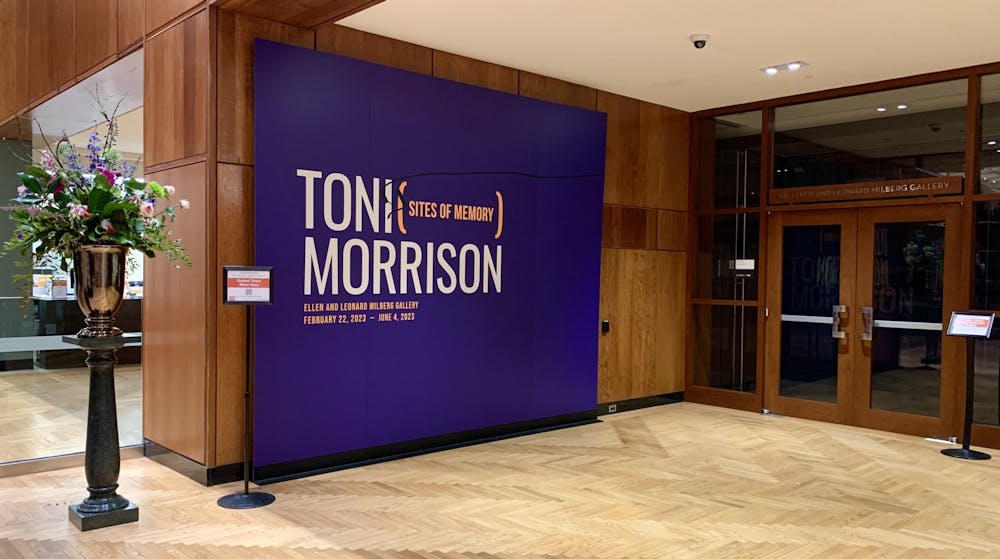Toni Morrison was the Robert F. Goheen Professor in the Humanities at Princeton University for 17 years. Today, her legacy continues to sustain and reconfigure the philosophy of storytelling. At Firestone Library’s Milberg Gallery, the new exhibition “Toni Morrison: Sites of Memory” reveals the author’s creative process through rare manuscripts, letters, and other archival materials.
The exhibition displays 75 objects, including original manuscripts of her works; messages, outlines, and pitches exchanged with editors; the first edition of Morrison’s debut novel, “The Bluest Eye”; and handwritten diagrams that map the physical and psychological movements of her characters in “Beloved.” “Sites of Memory” welcomes literary critics, aspiring writers, historians, and anyone interested in learning more about the origins of Morrison’s revolutionary writing.
On the back wall, there is a two-hour long video interview in which Morrison discusses her personal and literary past as part of a project hosted by Boston University. The space is imbued with quiet, intimate history; Morrison’s documents show authentic age and use with their weathered texture and water stains, her brisk handwriting in pen or pencil, and burnt spots leftover from a house fire that destroyed a portion of her original manuscripts. These archives illuminate Morrison’s private authorial experiences and showcase the source materials, techniques, and ideas that serve as the basis of her stories.
In Morrison’s own words, her writing process was “a kind of literary archaeology” — she reconstructed stories from the remnants of worlds that have been neglected by history and literature. There is a constant tension between Black individuals and the worlds that they exist in and move between. Morrison’s writing process addresses this tension by transcending the boundaries of time and space. When forming and revising stories, Morrison referred to “thereness-ness,” a concept that describes her imagination of internal and external movement through locations. Based on “thereness-ness,” Morrison thought in terms of topography and distance, using actual maps and outlines to organize her characters’ narrative paths and the structure of settings.
For example, the exhibition features yellow notebook pages covered in loose sketches and lively scribbles, which frame the physical movement of the characters in “Beloved” as they pass through places like the bedroom, restaurant, and kitchen. Another document focuses on psychological trajectories, or points in the novel where a character’s conception of their world is renewed or challenged. The exhibition also features photographs of Oklahoma that Morrison used to visualize the setting of her novel “Paradise.” Morrison designed time and place, not only for the characters in her stories, but also for her writing schedule. As a full-time mother and editor, the act of writing occurred in “interstitial spaces and unconventional locations.” “If it arrives you know,” Morrison said, describing the coming and going of words and inspiration. “If you know it really has come, then you have to put it down.”
Aside from her literary work and interviews, “Sites of Memory” spotlights Morrison’s personal narrative as a Black woman. A section of the exhibition titled “Genealogies of Black Feminism” depicts Morrison’s exploration of the complex relationship between Blackness and femininity in the late 20th-century women’s liberation movement — specifically, the question of how the category of a Black woman can exist without ignoring the differences between women in general. The exhibition contains a sampling of letters addressed to Morrison from Nina Simone, Toni Cade Bambara, and Hortense Spillers that reflect on their experiences as Black women. These documents capture the conversations and collaborative introspection that drive Morrison’s writing.
“A very large part of my own literary heritage is the autobiography,” Morrison explained in a letter shown at the end of the exhibition. Her writing represents Black histories and the stories of Black slaves as a whole, but is also deeply personal and intrinsic to her own life. Morrison’s stories go far beyond the limits of fiction — they continue to illuminate real-life experiences and reinforce the connection between an individual and their community.
“Toni Morrison: Sites of Memory” is open until June 4, 2023.

Annie Cao is a contributing writer for The Prospect. She can be reached at annie.cao@princeton.edu.









